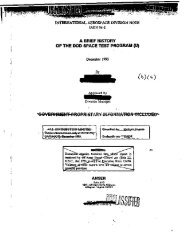LUNAR EXPEDITION PLAN
LUNAR EXPEDITION PLAN
LUNAR EXPEDITION PLAN
Create successful ePaper yourself
Turn your PDF publications into a flip-book with our unique Google optimized e-Paper software.
• •^teiJn*^;^*,*<br />
Mlcrotopograpby 1B being studied by the Army Corps of<br />
Engineers through radar experiments, (The Air Force work is<br />
being done on the Millstone radar equipment) The nature of<br />
the lunar dust is being studied primarily by the Air Force<br />
under Projects j6$Q and 6602 by means of radiometric studies<br />
from high altitude unmanned balloons and results are anticipated<br />
early 1962. NASA anticipates obtaining at least partial<br />
data on the nature of the dust from Surveyor {mid 1963) by<br />
television observation ot the lunar surface and by the landing<br />
characteristics of the vehicle.<br />
k.2-8.10<br />
The meteorite flux and level of solar and cosmic radiation<br />
near the lunar surface are important for the survival of personnel<br />
either on the lunar surface or in vehicles and shelters -<br />
Present knowledge of these parameters is fairly precise<br />
as a result of satellite and deep space probe experiments by<br />
NASA and the Air Force- Only the radiation environment within<br />
the first fev meters of the lunar surface is still speculative<br />
as a result of uncertainties in our knowledge of the interaction<br />
of solar and cosmic radiation with the lunar surface materials.<br />
It seems likely that a cloud of ions will be produced by radiation<br />
bombardment as veil as secondary X-rays. Dae density of the<br />
electron cloud is unknown, and may be critical for lunar communications.<br />
The Air Force is studying the lunar and cislunar radiation<br />
environment under Projects 6687, 6688, 7601, 7&9, and 7663 hh<br />
means of satellites, deep space probes, and vertical sounding<br />
rockets. The NASA Surveyor vehicle (mid-1963) should give detailed<br />
knowledge of the radiation environmeiit at the lunar surface.<br />
k.2.8.n<br />
The lunar magnetic field may be important to space and<br />
lunar surface navigation, and In its effects on ionized lunar<br />
materials.<br />
The Russian lunik II indicated that the lunar magnetic<br />
field must be very small.' The Russians were not clear on how<br />
small, but It is generally thought that the moon does not possess<br />
a magnetic field. Thus, all magnetic effects should be derived<br />
from the very low intensity Interplanetary field and magnetic<br />
fields, "frozen" Into solar plasmas.<br />
«.. iN» awr wr*-* «•<br />
4* : ;' *i?ttsvtt£<br />
^.30 WDIAH-S-458<br />
~*.<br />
;*?&**<br />
Ifcii ietamtfit IBMOIM inlanaotlaa mHtaira Hw national dofonw ml Id. Uniiad Eialai wiNiin (ha mMfiltH •( Hw Etpiomma tewi, Tltta<br />
If, U.S.C.. Saslion 7M on) 7f4, (hi Iraninlitiaa *t MvstaKM of wkicli In any aiannSt to an aflairtkorliad paiWn ii erafciblHil by low.




